|
Multi Cache -- North Burnaby N49 15.661 W122 55.637
Herbert Gilley
yelled
through the door. "This is your last chance. For God's sake get
out
of that room, woman," His wife refused to budge. She loved
her home and her neighbours. It was over her dead body that she
would
relocate. Barricaded in her bedroom parlour for a week, she refused to
accept any nourishment with the exception of tea and That is the
urban legend.
The truth of the matter is that Herbert Gilley was not yet married at
the
time his house was moved several blocks down the street. Placed
directly
beside a house he bought from Henry Hudson in 1912, the two structures
were joined with a brand new entrance hall. The result was a most
impressive mansion. It mattered little to Herbert Gilley that one
half of his new residence was designed in the Queen Anne style while
the
other half was Victorian Italianette. The architectural mix was
just
another symbol of Herbert Gilley's diverse and colourful life.
The
house still stands today.
The Gilley lands stretched from what is now Broadway up to Hastings including much of Burnaby Mountain. While logging the area, he was a hands-on employer who personally took charge of his employees' safety. In 1905 alone, Gilley shot 13 bears after an employee was mauled. The bear hides were proudly displayed in his lumber office.
Gilley was
also impressed
with the new machines available to the lumber industry and his company
was one of the first in British Columbia to own a Steam donkey.
Still,
much of the hauling was accomplished by beasts of burden.
The parkland has remained more or less unchanged since it was logged almost a century ago. The area once occupied by the cemetery is so dense with scrub and bush it is virtually impassible. There are a few nice walking trails, however. One of which is a ravine trail deep in the middle of the park. The cache can be found along this trail.
Because the parkland has remained largely undeveloped, traces of these logging camps can be seen in the form of garbage heaps. Storm lanterns, straight edged razors and broken teacups from the era have been found but most of the garbage is in the form of rusty tin cans. These middens have remained largely unmuggled due to the fact that most people don't know they exist and 100 years of forest growth have hidden them well. The one thing that is not in abundance along these creeks is quartz. At the time everyone knew that quartz sometimes contained gold and any gold bearing rock was a hint that the mother load could be close by. Because of this, the white stone was collected by everyone. THE CACHE
This cache may be considered a mini-multicache. There is only one stop before the final destination and it is directly along the route. The first waypoint is close to where the entrance of the long lost Cemetery once stood and along the same creek where Sam Conner's loggers once camped. The camp was most likely about 200m south where there is now a large parking lot, however. The cache is located at the edge of the park where the creek disappears under Lake City. Herbert Gilley's Logging camp was located Northwest at N49 15.934 W122 56.177 in what is now a housing development.
This hunt is great for dogs but small children may need help along certain sections of the trail. If you've found the right trail you will notice a major drop in GPS reception. It should get better as you head north. Depending on the weather the stream can go from a trickle to a torrent. Plan on getting your feet wet if you visit the cache during heavy rains. Warning: Spoilers Below. The cache can be found where the creek makes a sharp S turn around a tree with its roots hugging a boulder. If you find the area shown in the photograph (right) you are very close. This area of the park is not busy but many children play in the area. Please rehide the cache well. Enjoy your
visit.
|

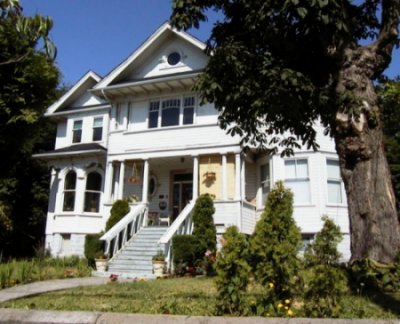 scones.
"Then stay if it pleases you -- you stubborn old trout" Mr.
Gilley
barrelled down the stairs and slammed the front door in a huff.
It
was then he ordered the workmen to begin the task at hand and within
minutes
his house was lifted off its foundation and began to rumble and roll
down
Queens Avenue -- with Mrs. Gilley locked inside shrieking in terror all
the way.
scones.
"Then stay if it pleases you -- you stubborn old trout" Mr.
Gilley
barrelled down the stairs and slammed the front door in a huff.
It
was then he ordered the workmen to begin the task at hand and within
minutes
his house was lifted off its foundation and began to rumble and roll
down
Queens Avenue -- with Mrs. Gilley locked inside shrieking in terror all
the way. 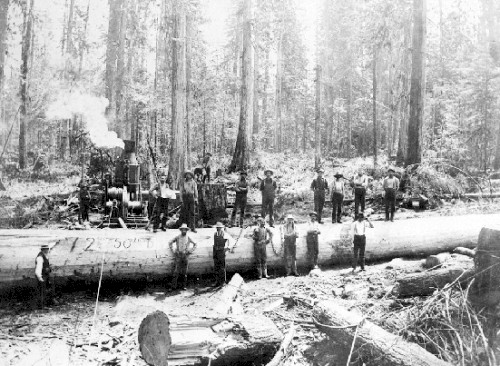
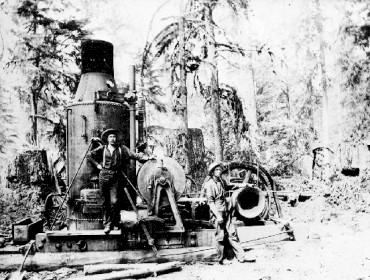


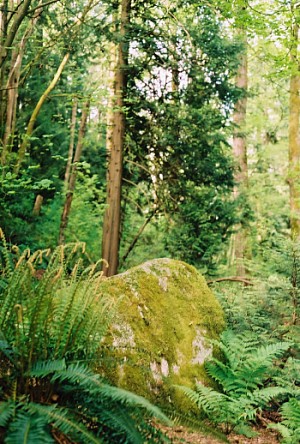 When
visiting this cache, keep in mind that the surrounding creeks were used
by the workers involved in local logging operations. The creek
right
beside the intersection of Underwood and Broadway was the site of Sam
Conner's
Logging camp. Broadway was one of the first roads cut in the area
to haul lumber.
When
visiting this cache, keep in mind that the surrounding creeks were used
by the workers involved in local logging operations. The creek
right
beside the intersection of Underwood and Broadway was the site of Sam
Conner's
Logging camp. Broadway was one of the first roads cut in the area
to haul lumber. 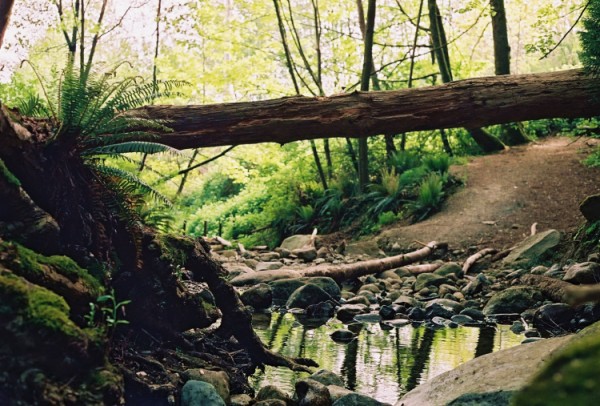
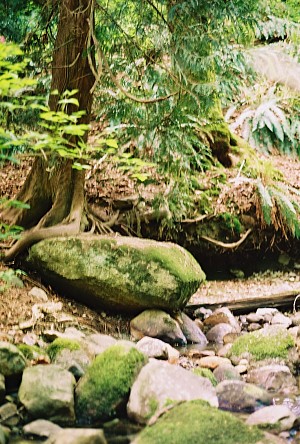 The
closest street parking is along Underhill Avenue just south of
Broadway.
Along a dirt road that borders the south end of the park you will see
several
trails leading into the bush. The smaller trails do not join up
and
impatient people looking for a shortcut may find themselves
backtracking.
The
closest street parking is along Underhill Avenue just south of
Broadway.
Along a dirt road that borders the south end of the park you will see
several
trails leading into the bush. The smaller trails do not join up
and
impatient people looking for a shortcut may find themselves
backtracking.